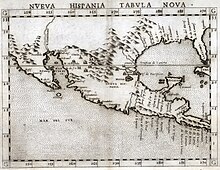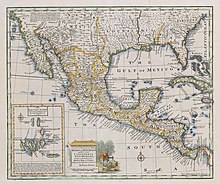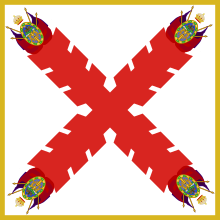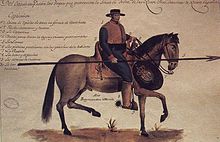Viceroyalty of New Spain


The viceroyalty of New Spain ( Spanish Virreinato de Nueva España ; 1535-1821) was the first of the five or four administrative areas of Spain in Latin America , each of which was headed by a viceroy . The Viceroyalty comprised the present-day states of Mexico , Belize , Guatemala , El Salvador , Honduras , Nicaragua , Costa Rica , Venezuela and the Caribbean Islands , in Asia the Philippines , the Marianas , the Carolines andNorth Borneo . In the 17th and 18th centuries, other parts of western and southwestern North America were added, including today's US states California , Arizona , New Mexico , Texas , Nevada , Colorado , Utah and southwest Wyoming . In 1762 western Louisiana was ceded by France to Spain and incorporated into the viceroyalty; however, in 1800 the area was returned to France under pressure from Napoleon .
In 1717 Venezuela was annexed to the newly founded viceroyalty of New Granada . The Bay Islands were ceded to Great Britain in 1643, Jamaica (Santiago) in 1655 , the Cayman Islands in 1670 , Trinidad in 1797 and Belize in 1798. In 1697 the smaller western part of Hispaniola ( Haiti ) was given to France. The claim to power over the Nootka Territory , which was sparsely colonized in 1789 , was withdrawn just five years later under pressure from Great Britain.
With New Spain (central and part of North America) and the viceroyalty of Peru (in South America), from which the viceroyalty of New Granada and La Plata were later separated, Spain ruled de jure over all of Latin America (with the exception of Portuguese Brazil ).
Pre-Columbian period
Mesoamerica was settled long before Columbus reached America in 1492 . The first mammoth hunters were around 10,000 years ago. The first plants were domesticated around 7000 years ago .
Around 300 BC The construction of Teotihuacán began, which peaked around 600 AD with a population of 150,000 to 200,000. Different peoples, such as the Zapotec , Mixtec and Maya lived in the vast city . After more than 1000 years, Teotihuacan's power was broken. The city was probably defeated by the Toltecs in a war around AD 750 and was sacked. The Toltecs played a leading role in Mesoamerica until the 12th century. But they too were defeated by the Chichimecs in a war .
In the 14th century, the Aztecs migrated from the north to the area of Lake Texcoco . They founded their capital Tenochtitlan on an island in the middle of the lake . At first they hired themselves out as mercenaries with their neighboring peoples. But very quickly they rose to the dominant power in Mesoamerica and subjugated almost all other peoples. Together with the cities of Texcoco and Tlacopan , they formed an alliance. The Aztecs assumed the leading role in this Triple Alliance.
Founding of the viceroyalty
After his voyage of discovery, Christopher Columbus received the hereditary title of viceroy over the newly discovered “Indian” areas. He chose his seat in Santo Domingo (until 1497 La Isabela was the seat of the viceroy) on the island of Hispaniola , which he had discovered himself. His territory, the Viceroyalty of Las Indias (Virreinato de las Indias), was restricted to the Caribbean islands discovered by Columbus himself after long legal disputes with Columbus' son and heir Diego Columbus . Heredity was also subsequently abolished.
Until 1524, the viceroy of "las Indias" was subordinate to the Council of India (Consejo de Indias) and thus to the influential Bishop of Burgos Juan Rodríguez de Fonseca . After his death in March 1524, Emperor Charles V enlarged the organization. It was converted into an independent institution and was officially called Real y Supremo Consejo de Indias . It was directly subordinate to the king and was intended as a control body for the viceroys and governors of the colonies.
On the mainland, Hernán Cortés conquered the Aztec Empire in 1521 and was appointed Governor General of the province of "New Spain" founded in 1523 by Charles V , which consisted of the areas conquered in Central America. In 1530, Cortés was replaced by Antonio de Mendoza , who did not arrive in Mexico City until 1535 . Mendoza became the first viceroy of the newly founded empire in 1535 as the "Viceroy of New Spain", which now encompassed all Spanish possessions in America, including the Caribbean islands.
Later other viceroyalty kingdoms of Spain followed in South America:
- After the conquest of the Inca Empire (from 1532) the viceroyalty of Peru was founded in 1542 ,
- the viceroyalty of New Granada was split off temporarily from Peru in 1717 and finally in 1739,
- the viceroyalty of Río de la Plata was split off from Peru in 1776.
administration
The viceroy resided in his own palace in Mexico City . The provincial governors reported to him and his administrative apparatus. The administration was very centralized.
The judiciary of the Viceroyalty was divided into the four American districts of the courts of appeal ( Real Audiencias ) in Santo Domingo (from 1511), Mexico (1527), Guatemala (1543) and New Galicia (1548). From 1583 an Audiencia for the Philippines was also set up in Manila .
In 1776 the reforms of Charles III occurred . in force. They introduced another level of administration, the Intendencias , which took on essential tasks that had previously been with the Viceroy or the Audiencias. In addition, the remote and poorly developed areas in the north of the colony were separated from the viceroyalty as Provincias Internas and placed directly under the king until 1786. This included what is now Coahuila , Texas , Nuevo León , Sonora , Sinaloa , California, and New Mexico .
A colonial police force , the dragones de cuera (leather dragoon ), was set up at the beginning of the 18th century to secure the border and fight against Indians on Mexico's northern border . This force was incorporated into the Mexican National Army after Mexico gained independence and disbanded in the mid-1840s.
business
In 1503 the encomienda system was created. Here, the conquistadors were given large estates with all the indigenous people living on them for administration. These Indians were called Naborios , according to the law they were not slaves . In practice, they could be forced to do unpaid work. Since they did not belong to the feudal taker called Encomendero, he did not take any responsibility for them. Formally, the encomendero for the protection and the evangelization of the Indians should worry, but in the silver mines and on the sugar cane - plantations were often exploited to death. In the beginning, encomiendas were only given for one generation. So they could not be passed on to subsequent generations. However, that changed after an uprising.
In the years 1542/43 the Leyes Nuevas (the "new laws") were enacted to protect the Indian population. Especially in remote areas, the new laws could do little to change the slave-like treatment of the Indians. In practice, the encomienda system was simply continued, because violations were often not penalized at all or only to a small extent.
The primary economic interest of motherland Spain was the exploitation of America's mineral resources. Gold and silver were mined in mines and shipped to Europe in coin form.
In addition to supplying its own population, agriculture on plantations primarily produced tobacco and sugar cane for export to Europe on the islands of the Caribbean. The male Taínos were all but wiped out as labor , and slaves were imported from Africa instead. The coveted right to supply the viceroyalty was monopolized and was given to slave traders from France and England .
Trade between New Spain and other countries was strictly limited: goods from Europe were only allowed to be sent from Cádiz to Veracruz via the established route and were subject to high tariffs and restrictions. The Spanish colonies of America were only allowed to intervene after the reforms of Charles III. trade at the end of the 18th century.
End of the viceroyalty
In terms of foreign policy, New Spain was shaped for many years by the competition between Spain and England for supremacy in the Caribbean . With the independence of the United States in 1776, this power structure began to move, and the idea of a state structure independent of the motherland also grew among the Mexicans.
When Napoléon Bonaparte occupied Spain in 1808 and forced King Ferdinand VII into exile, he indirectly triggered the independence movement in Mexico. As in the mother country, the protest against the Bonapartists was formed, government committees (juntas) took responsibility. The Spanish upper class in New Spain was divided: the strictly conservative forces refused to take the initiative and persistently waited for legitimate orders from the incapacitated king. Reformists and liberals saw the need to act and to continue to manage the colony administratively and politically under their own responsibility. The spectrum ranged from pragmatists who only wanted an interim solution until the return of the legitimate king, to radicals for whom the goal was the complete independence of the American state from Europe.
In 1810 the War of Independence broke out with Miguel Hidalgos Grito de Dolores , which, curiously, was directed against the colonial government in the name of the Spanish king. When the Cortes of Cádiz promulgated the liberal constitution of Cádiz (1812), the conservative viceroy Francisco Javier Venegas resigned. In 1814 Ferdinand returned to Spain from exile, repealed the constitution and ruled absolutistically; militarily, the independence movement was suppressed for the time being.
The end of Spanish colonial rule came with the liberal revolution of 1820 in Spain. The unity of the Prospanical forces in Mexico broke up into a liberal and an absolutist camp, and the lack of legitimation of governmental power made the advocates of independence on the advance. Resistance flared up again under Vicente Guerrero . When Colonel Agustín de Iturbide defected with the majority of the royalist troops to the side of the rebels in February 1821, the war was militarily decided. The Spaniards held only a few cities, and the last de facto viceroy, Juan O'Donojú , sent by the liberal government , was only able to seal Mexico's independence in the Treaty of Cordoba of August 24, 1821. The successor state was the Empire of Mexico (1821–1823) .
Other parts of the former Viceroyalty - such as the Philippines and Cuba - remained under Spanish rule; the governors there reported to the overseas ministry in Madrid.
See also
literature
- Walther L. Bernecker , Raymond Th. Buve, John R. Fischer, Horst Pietschmann (eds.): Handbook of the history of Latin America . 3 volumes. Klett-Cotta, Stuttgart 1994, ISBN 3-608-91495-1 .
- Klaus-Jörg Ruhl and Laura Ibarra García: Small History of Mexico. From the early days to the present . 2., updated Ed., CH Beck, Munich; Beck 2007, ISBN 978-3-406-42166-2 .
- Gloria M. Belgado de Cantú: Historia de México - Legado histórico y pasado recente . 2nd Edition. Pearson Educación, Mexico City, Mexico 2008, ISBN 978-970-26-1274-2 .
Web links
Remarks




